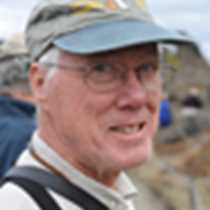The South Orkney Islands
Once the waters around the Southern Continent teemed with whales. The accounts of early Antarctic explorers tell of almost daily encounters with giant blue and fin whales. Commercial whaling around Antarctica began in 1904 on South Georgia Island. By 1906 it spread to the South Shetlands, the South Orkneys, and the Antarctic Peninsula. On our trip we have seen the wreckage of the whaling station at Deception Island and the beached bones of great whales at Port Lockroy and Cuverville Island. The whalers, particularly the pelagic floating factories of the mid-twentieth century, were brutally efficient. Whale numbers were drastically reduced. Now these whales, especially blues, are rarely seen. Today we defied history. We found blue whales!
We left Elephant Island yesterday evening for a crossing to the South Orkneys. With no land in sight, some might have thought it a time to rest, to catch up on reading and organize their myriad photos. Ah, but they were wrong! It was the watchman on the bridge who first spotted the tall, columnar spouts; thanks, Morel! As we approached we were afraid to believe what our eyes and binoculars were telling us. Yes, there were fin whales, but with them were blues, and even better, a female blue whale accompanied by a calf. Their mottled blue-gray color and tiny dorsal fin set way aft on the back made it unmistakable. Photo organizing was deferred yet again as we all rushed to our favorite viewing locations. This trip has been an extraordinary cetacean banquet: blues, fins, seis, minkes, humpbacks, Southern bottlenose and right whales, and the enigmatic beaked whale. We can only hope that the great whales will continue to recover from their past depredation so that the sights that have so enthralled us will no longer be considered extraordinary.
We continued on to the South Orkneys where we again took to our Zodiacs. The concentration of life was simply incredible. Within minutes of leaving the ship we found an iceberg with six leopard seals and a single crabeater seal, all apparently living in peaceful coexistence. The land was painted with chinstrap penguins (and with their leavings). We watched penguins gathering on the wave-smoothed rocks below the nesting areas. No doubt, the wary penguins were aware of the leopard seals patrolling along the shoreline but there were young penguins waiting to be fed. With a sudden rush, groups of adult penguins made their dash to the sea, and returning penguins popped out of the water, having avoided the leopard seal once more, to trek again up the steep slope to feed their hungry young. We all tried to capture the exact moments of the penguins’ coming and going.
Antarctic fur seals rested on land and cavorted acrobatically in the near shore waters. Weddell seals lounged on ice and shoreline rocks. Chinstrap penguins stood on the sheer slope of an impossibly blue iceberg that was smoothed and sculpted by the waves. So much to see, to absorb, to photograph, to remember.



